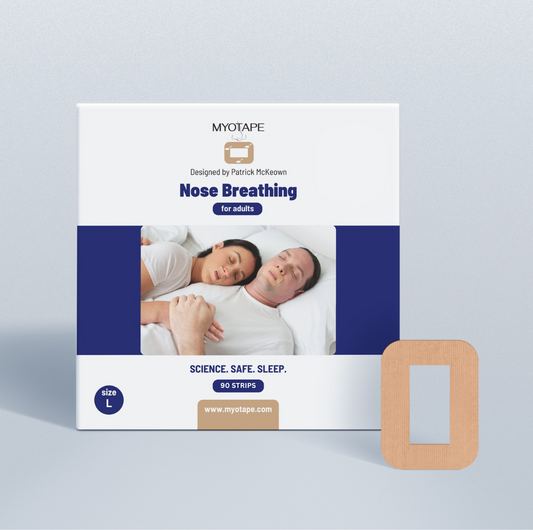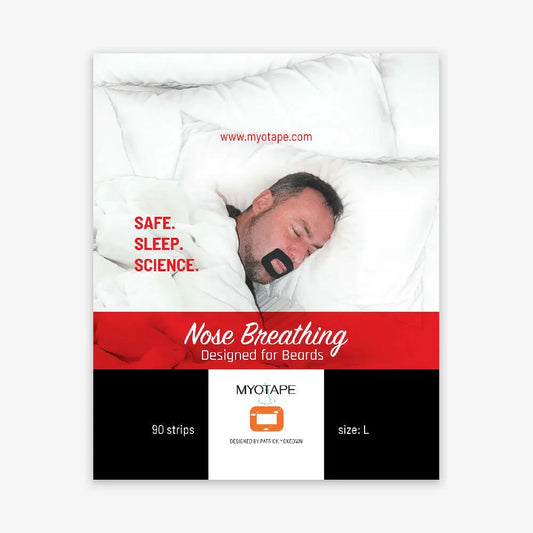Trying something new, like mouth taping, can be exciting, especially when you’re eager to see improvements in your sleep.
However, you may find yourself wondering: how do I tell if mouth taping is working for me? The good news is there are clear signs to look for, and we’re here to walk you through them.
In this article, we’ll walk through them together, so you’ll know exactly what to look for. But first, let us get to know the basics of mouth taping.
The Basics of Mouth Taping
Mouth taping is the practice of placing a small strip of adhesive tape, like MyoTape, around the lips during sleep to keep the mouth closed. This simple method encourages nasal breathing, which is widely recognized as the healthier and more efficient way to breathe at night.
Many people turn to this approach to ease snoring, train themselves to stop mouth breathing, improve sleep quality, and prevent the dry mouth that often comes with nighttime mouth breathing.
Its effectiveness lies in the natural advantages of nasal breathing, which support the body in ways mouth breathing cannot.
Nasal breathing provides important benefits such as:
- Filtering dust, allergens, and airborne particles
- Regulating the temperature and humidity of inhaled air
- Improving oxygen uptake and overall energy levels
- Supporting circulation and immunity through nitric oxide production
However, does mouth taping really work to support breathing through the nose? A 2020 study involving more than 300 children who were habitual mouth breathers found that most could comfortably switch to nasal breathing when their mouths were gently taped.
This suggests that with the right approach, mouth taping can help train the body to switch to nasal breathing, potentially alleviating issues such as dry mouth, restless sleep, or snoring.
Let’s say you’ve started mouth taping, how can you tell if it is working?

Signs That Mouth Taping Is Working
When you start mouth taping, the results can be subtle at first. Over time, small changes in how you feel and how you sleep can reveal whether it’s making a difference. Here are some practical signs to look for:
1. Waking up refreshed
When mouth taping begins to work, mornings often feel lighter and less like a struggle.
This new sense of energy can be one of the clearest ways to tell if mouth taping is working.
2. Less dry mouth
A sticky, dry mouth in the morning usually means you’ve been breathing through your mouth at night.
If mouth taping reduces this, it may be a sign that nasal breathing is becoming your default.
3. Longer, more continuous sleep
Interrupted nights can leave you feeling like you never truly rested.
Noticing longer stretches of uninterrupted sleep is often an early sign that mouth taping is starting to make a difference.
Even if you wake up, you are able to go back to sleep quickly.
4. Reduced snoring and easier breathing
Snoring often improves when the mouth stays gently closed, allowing the nose to do the work.
If your partner notices quieter nights, it could be a clue that mouth taping is helping.
5. Steadier daytime energy
The benefits of mouth taping often show up during the day as much as at night.
Feeling less drowsy during conversations, driving, or work may reflect that your sleep quality is improving.
6. Fewer nighttime bathroom trips
Frequent waking to use the bathroom can sometimes be linked to disrupted breathing and lighter sleep.
If mouth taping helps you stay asleep longer, those nighttime trips may become less frequent.
7. Better endurance and recovery
Improved nasal breathing during sleep can support more efficient recovery.
When mouth taping is working, you may notice more stamina in workouts and steadier energy in daily life.

How Long Does It Take to See Results from Mouth Taping?
The timeline for noticing changes from mouth taping is not the same for everyone.
Some people experience small improvements within just a night or two, such as waking up with less dry mouth or finding nasal breathing feels more natural.
These early shifts can be encouraging signs that the practice is beginning to take effect.
For others, the benefits appear more gradually, as you get used to mouth taping.
It may take two to four weeks of consistent use before deeper sleep, reduced snoring, or waking with more morning energy become noticeable.
This slower progress is still a positive indicator of how long mouth taping takes to show results.
In most cases, the answer to how long it takes to see results from mouth taping is a mix of both short-term relief and longer-term benefits.
Quick improvements in comfort often come first, while bigger changes in sleep quality and daily energy tend to build over time.
What If Mouth Taping Does Not Work?
It can feel discouraging if mouth taping does not work as expected. Some people notice little to no change because of nasal blockage, using the wrong kind of tape, inconsistent use, or an underlying condition such as sleep apnea.
When mouth taping is not working and becomes a pattern, it is best to troubleshoot. Clearing nasal passages before bed, switching to MyoTape, which is a skin-friendly, hypoallergenic tape designed for comfort, or committing to regular use can often make a difference. For others, the real reason why mouth tape does not work may lie in an undiagnosed medical issue.
Seek Medical Advice: If you struggle to breathe through your nose, feel anxiety or panic with tape in place, or see no improvement after several weeks, it is best to stop. A healthcare professional can help determine if conditions like sleep apnea or chronic congestion are the reason the mouth tape is not working for snoring or sleep quality.
How to Maximize the Benefits of Mouth Taping
To get the most from mouth taping, a few practical steps can make the experience safer and more effective:
- Choose skin‑friendly, hypoallergenic tape such as MyoTape, which is designed to be gentle while still encouraging nasal breathing.
- Clear your nasal passages before sleep with a rinse, spray, or simple breathing exercises to ensure airflow feels natural.
- Stay consistent by using tape nightly, giving your body time to adapt to the new habit.
- Track your progress with a sleep app, wearable device, or feedback from a partner to see if snoring, sleep quality, or morning energy improve.
- Try breathing exercises such as those from the Buteyko Method, which can help retrain your breathing patterns and make nasal breathing feel easier both during the day and at night.
These small adjustments can help ensure that mouth taping works as intended, turning it into a reliable tool for better rest and daily energy.
MyoTape Will Work for You!
So, does mouth taping work? For many people, the answer is yes, but the results depend on choosing the right tape, being consistent, and paying attention to the signs of progress.
MyoTape makes this process easier and safer. Designed by breathing expert Patrick McKeown, it gently surrounds the lips without sealing them shut, allowing you to breathe comfortably while encouraging nasal breathing through the night. Unlike other tapes, MyoTape is skin‑friendly, hypoallergenic, and versatile.
Head to the MyoTape online shop, and choose from a variety of options designed for everyone, including mouth tape for kids, mouth tape for adults, mouth tape for sensitive skin, and mouth tape for beards.








